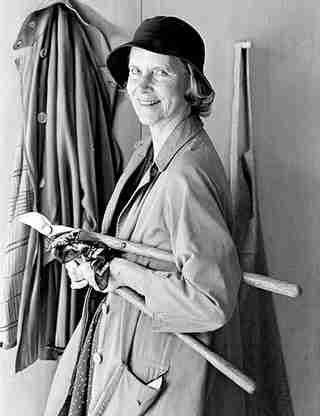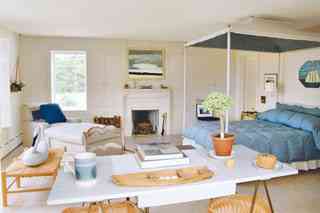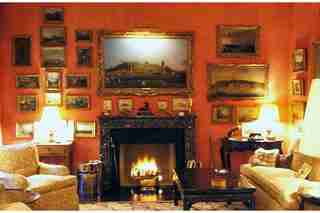A Look at Bunny Mellon’s Gardens and Homes Sourced from Her Archives

dam-images-architecture-2014-06-bunny-mellon-slide-show-bunny-mellon-slideshow-01-portriat.jpg
Bunny Mellon, at Oak Spring Farms, her 4,000-acre estate in Upperville, Virginia, in the 1980s.
The heiress, who died on March 17th at age 103, was known for her design acumen . She gave so much attention to what she wore, how she lived, and what she planted; she even had her gardening apparel custom made by two favorite couturiers: Cristóbal Balenciaga and, after his death, Hubert de Givenchy.

dam-images-architecture-2014-06-bunny-mellon-slide-show-bunny-mellon-slideshow-03-osterville-massachusetts-bedroom.jpg
Bunny Mellon’s bedroom at her 26-acre estate in Osterville, Massachusetts, which is now owned by businessman William I. Koch. The enameled-metal bed with a ruffled canopy was a model that she specified often for her homes; several were kept in storage for future use. Regional expressions were frequent in her interior decoration, including the seascapes, swan figure, and boat models shown here.

dam-images-architecture-2014-06-bunny-mellon-slide-show-bunny-mellon-slideshow-02-paul-mellon-nyc-study.jpg
Paul Mellon’s study at the couple’s townhouse in New York City, decorated with the help of several interior designers, including John Fowler, Paul Leonard, Billy Baldwin, and Bruce Budd. Gilt-framed antique landscapes fill the walls, which have been painted a rich coral.
dam-images-architecture-2014-06-bunny-mellon-slide-show-bunny-mellon-slideshow-05-osterville-massachusetts-gardens.jpg
A detail of the garden at the Mellon estate in Massachusetts, with mounds of blue salvia in the foreground and towering sunflowers flanking the octagonal garden shed.
dam-images-architecture-2014-06-bunny-mellon-slide-show-bunny-mellon-slideshow-06-osterville-massachusetts-grounds.jpg
A gate at the Mellons’ Massachusetts home.
dam-images-architecture-2014-06-bunny-mellon-slide-show-bunny-mellon-slideshow-04-osterville-massachusetts-home.jpg
At Mellon’s house in Massachusetts, country-style flowers, including goldenrod and cosmos, fill a stoneware vessel atop a painted table; positioned beneath the table are bird sculptures that reference the wildlife in the area.
dam-images-architecture-2014-06-bunny-mellon-slide-show-bunny-mellon-slideshow-08-virginia-greenhouse.jpg
French artist Fernand Renard painted trompe l’oeil scenes on the storage cabinets that line a room at the Mellons’ greenhouse complex in Virginia. One cabinet door includes an image of a ring hung on a ribbon. Once the door was opened, there was a hook with a ribbon, onto which Bunny Mellon safely threaded her wedding band before gardening.
dam-images-architecture-2014-06-bunny-mellon-slide-show-bunny-mellon-slideshow-07-oak-spring-garden-library.jpg
The Oak Spring Garden Library at the Mellons’ Virginia stud farm was designed in 1980 by modernist architect Edward Larrabee Barnes to hold Bunny Mellon’s thousands of rare garden books and horticulture manuals. In this corner, a flowered rug is laid on the diamond-pattern painted floor, and a library ladder stands at the ready. The library is open to scholars by appointment.
dam-images-architecture-2014-06-bunny-mellon-slide-show-bunny-mellon-slideshow-10-antigua-bedroom.jpg
A light palette, a diamond-motif floor painted by Paul Leonard and William Strom, furniture with a French colonial mien, and framed museum posters decorated a bedroom at Bunny Mellon’s house in Antigua, British West Indies. The architect of the building, which is currently for sale through Christie’s, was the American neoclassicist H. Page Cross. He also designed the Mellons’ New York City townhouse, their residence in Massachusetts, barns and tenant houses for them in Virginia, and Trinity Episcopal Church in Upperville, Virginia, where Bunny Mellon’s funeral was held.
dam-images-architecture-2014-06-bunny-mellon-slide-show-bunny-mellon-slideshow-09-virginia-greenhouse.jpg
A detail of Fernand Renard’s trompe l’oeil cabinets at the Virginia greenhouse complex, showing the tools of a gardener’s trade—among them, baskets, twine, and a watering can. At right is a potted myrtle tree manicured into a tidy sphere, a form that Mellon cultivated and popularized, having been inspired by illustrations of similar trees in medieval manuscripts.